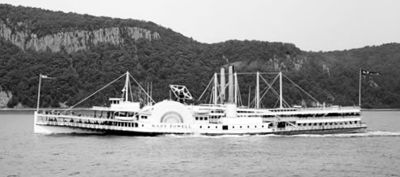

Mary Powell in 1900.
Soon after she completed, the Herreshoffs steamed her down Long Island Sound to New York City. There, on 10 June, they took on the 300-foot Mary Powell, the fastest and best known Hudson River steamboat of her generation, during a scheduled northbound run from West 22nd Street. Dwarfed at first as she glided alongside the giant side-wheeler’s starboard bow, Stiletto soon surged ahead and completed the 30 miles to Sing Sing in 77 minutes with a two-mile lead. The next day, an article in the New York Times proclaimed her “a perfect water knife.”
Length: 94' between perpendiculars.
Beam: 11'.
Displacement: 31 long tons.
Draft: 4' 10".
Fuel: egg coal.
Boiler: sectional water tube-type 7-ft by 7-ft carrying 160-lbs of steam.
Engine: inverted compound condensing-type engine with 12.6- and 21-in diameter cylinders; 359 ihp (450 ihp under forced draft); 1 shaft.
Screw: 4' diameter. 4 blades; 400 rpm.
Trial speed: 23.3 knots.
Torpedo battery: 2 x 18-inch torpedoes (1898).
Stiletto’s startling demonstration of speed was not lost on the Navy. On 3 March 1887, Congress authorized her purchase as an experimental torpedo boat and that July, the Navy placed her in commission as Wooden Torpedo Boat No. 1 at the Torpedo Station at Newport, where she remained a fixture for nearly 25 years.
Stiletto was the Navy’s first vessel capable of launching the self-propelled Howell torpedo, initially from a centerline tube mounted in her bow and later also from a trainable tube mounted on deck (see top photograph). Coal-fired as built, she was modified in 1897 to burn fuel oil but trials were disappointing.
Stiletto was struck from the Navy list on 27 January 1911 and sold for scrapping on 18 July to James F. Nolan of East Boston, Massachusetts.
Sources: Nathanael Greene Herreshoff Naval Architecture and Engineering notes, courtesy Herreshoff Museum; Bauer & Roberts, “The Mary Powell Beaten,” New York Times, 11 June 1885.